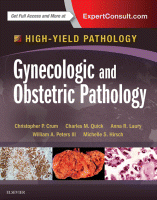Physical Address
304 North Cardinal St.
Dorchester Center, MA 02124

D efinition — A microacinar arrangement of endometrioid epithelium seen in endometrial biopsies/curettings that signifies the presence of endometrial neoplasia. Clinical Features Epidemiology Most commonly occurs in postmenopausal women in their sixth and seventh decades. You’re Reading a Preview Become…

D efinition — Alteration of the epithelial cells consisting of tubular differentiation, including oxyphilic cytoplasm. Clinical Features Epidemiology Tubal metaplasia is common, although clonal expansions of tubal metaplasia are less so. Eosinophilic metaplasia is an uncommon entity. Both tubal and…

D efinition — An endometrial malignancy composed almost entirely of squamous carcinoma. Clinical Features Epidemiology Rare, comprises less than 1% of uterine endometrial carcinomas. Most commonly occurs in postmenopausal women in their seventh and eighth decades. Usually not associated with…

D efinition — Extensive, superficial endometrial squamous (nonmorular) metaplasia. Clinical Features Epidemiology Ichthyosis uteri is rare. It is seen in patients with longstanding irritation of the endometrium (intrauterine device [IUD] or chronic endometritis). In postmenopausal patients care should be exercised…

D efinition — Partial or complete replacement of an endometrial gland tract by a generally nonkeratinizing squamous metaplasia. Clinical Features Pathogenesis Squamous morules are seen at all ages, mostly in the fifth decade. Can be isolated, associated with minor gland…

D efinition — Change of the epithelium of the endometrium to a mucinous phenotype. Clinical Features Epidemiology Most commonly occurs in the perimenopausal to postmenopausal years. Papillary and microglandular forms are associated with a significantly increased risk of a coexisting…

D efinition — Surface changes in the endometrium associated with breakdown and injury. Clinical Features Epidemiology Most commonly occurs in the fifth decade associated with endometrial breakdown or injury (submucosal leiomyoma or polyp). You’re Reading a Preview Become a Clinical…

D efinition — Degenerative changes of the surface epithelium associated with breakdown and ischemia. Clinical Features Epidemiology Most commonly occurs in the fifth decade. Associated with anovulatory bleeding or other unscheduled breakdown, including polyps and submucosal leiomyomas. You’re Reading a…

D efinition — Involvement of the endometrium by endocervical glandular neoplasia, either by direct extension or by contamination during sampling. Clinical Features Epidemiology True endometrial involvement (direct extension) by endocervical adenocarcinoma is rare. Not uncommonly, endometrial biopsies in patients with…

D efinition — A polypoid neoplasm composed of atypical glands and smooth muscle stroma. Clinical Features Epidemiology Atypical polypoid adenomyomas (APAs) are rare neoplasms. Typically seen in the fifth decade. You’re Reading a Preview Become a Clinical Tree membership for…